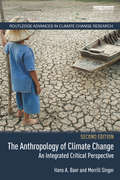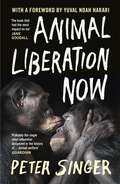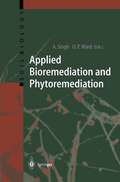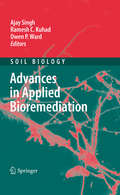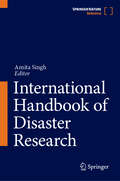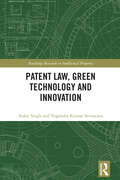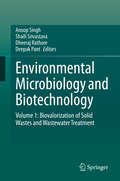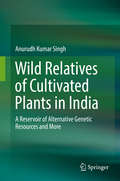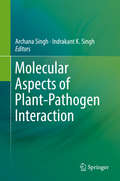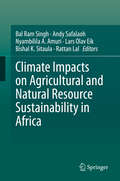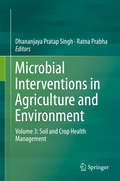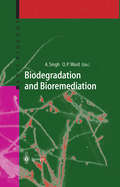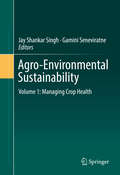- Table View
- List View
The Anthropology of Climate Change: An Integrated Critical Perspective (Routledge Advances in Climate Change Research)
by Merrill Singer Hans A. BaerIn addressing the urgent questions raised by climate change, this book provides a comprehensive overview of the anthropology of climate change, guided by a critical political ecological framework. It examines the emergence and slow maturation of the anthropology of climate change, reviews the historic foundations for this work in the archaeology of climate change, and presents three alternative contemporary theoretical perspectives in the anthropology of climate change. This second edition is fully updated to include the most recent literature published since the first edition in 2014. It also examines a number of new topics, including an analysis of the 2014 American Anthropological Association’s Global Climate Change Task Force report, a new case study on responses to climate change in developed societies, and reference to the stance of the Trump administration on climate change. Not only does this book provide a valuable overview of the field and the key literature, but it also gives researchers and students in Environmental Anthropology, Climate Change, Human Geography, Sociology, and Political Science a novel framework for understanding climate change that emphasizes human socioecological interactions.
The Survival Game
by Nicky Singer'A wonderful, surprisingly delicate story about a teenager making her way home to Scotland in a world remade by climate change (aimed at YA readers but, like all good children's books, good for adults too)' Lucy Mangan, i WeekendIn a world full of checkpoints and controls, can love and hope defy the borders? A searing, timely story, as arresting as it is beautiful. Imagine a world ... Where there are too many people on a too-hot earth and your only chance of salvation is to journey north.Where you must prove yourself worthy of existence at every turn, at every checkpoint.Where your instincts become your most powerful weapon - even more than the gun in your pocket.Where you find out what it takes to survive.An extraordinary story about survival and what it costs, about the power of small kindnesses to change everything.
Animal Liberation Now
by Peter SingerThe definitive case for radically rethinking humanity's relationship with other animals - for the good of us all. 'The book that had the most impact on me' JANE GOODALL'Probably the single most influential document in the history of ... animal welfare' GUARDIANIn 1975, Animal Liberation started a global movement when it uncovered the abuse of animals in factory farms and laboratories and showed these horrific practices to be morally indefensible. In the decades since, science has vindicated Peter Singer’s arguments about animal sentience, plant-based diets have become mainstream and his landmark book has changed millions of minds. And yet, for animals, the situation has grown worse.Fully rewritten for the twenty-first century, Animal Liberation Now reveals these new developments and refines its arguments to address the pressing problems of today, including the impact of meat consumption on the climate emergency and the spread of lethal new viruses. A book of galvanising power and importance, it shows that the need to radically rethink our relationship with animals is more pressing than ever.'Will motivate a new generation of readers who are resolutely committed to creating a just society for all' JOAQUIN PHOENIX'The indispensable foundational text for the movement, new and updated' J. M. COETZEE'One the most important books of the last 100 years' ECOLOGIST
Applied Bioremediation and Phytoremediation (Soil Biology #1)
by Ajay SinghThe huge expansion of the chemical and petroleum industries in the twentieth century has resulted in the production of a vast array of chem ical compounds and materials that have transformed our lives. The associated large-scale manufacturing, processing and handling activi ties have caused a serious deterioration in environmental quality and created threats to human health. These negative impacts have led to responses and regulations requiring remedial action in support of envi ronmental sustainability. of biotechnological methods through bioremediation, Application has gained prominence as an option for soil remediation methods. Bioremediation is a multidisciplinary approach where biologists, chem ists, soil scientists and engineers work as team to develop and imple ment remediation processes. Bioremediation has now been used successfully to remediate many petroleum-contaminated sites. However, there are as yet no commercial technologies commonly used to reme diate the most recalcitrant contaminants. Nevertheless, bioremediation is a rapidly advancing field and new bio-based remedial technologies are continuing to emerge.
Advances in Applied Bioremediation (Soil Biology #17)
by Ajay Singh Ramesh C. Kuhad Owen P. WardBioremediation is a rapidly advancing field and the technology has been applied successfully to remediate many contaminated sites. The goal of every soil remediation method is to enhance the degradation, transformation, or detoxification of pollutants and to protect, maintain and sustain environmental quality. Advances in our understanding of the ecology of microbial communities capable of breaking down various pollutants and the molecular and biochemical mechanisms by which biodegradation occurs have helped us in developing practical soil bioremediation strategies. Chapters dealing with the application of biological methods to soil remediation are contributed from experts – authorities in the area of environmental science including microbiology and molecular biology – from academic institutions and industry.
Translating the Paris Agreement into Action in the Pacific (Advances in Global Change Research #68)
by Anirudh SinghThis book provides an insight into how a country contributes to the GHG emissions reductions required to keep global warming within the limits set by the Paris Agreement arrived at COP21 in 2015. It shows what actions are needed for the implementation plan that Fiji will use to satisfy its quota (i.e. its Nationally Determined Contribution or NDC) of the total GHG emissions reductions. It is a primary resource material for those who wish to obtain an understanding of the science behind climate change mitigation. It reveals the behind-the-scenes action that takes place to convert the rhetoric of climate change into the action on the ground that actually reduces the GHG emissions and global warming. The book also presents a critique of methods adopted by nations in meeting their NDCs to emissions reductions as agreed at the Paris Agreement, and suggests improvements.
Patent Law, Green Technology and Innovation (Routledge Research in Intellectual Property)
by Ankit Singh Yogendra Kumar SrivastavaIn the era of modern industrial regimes, the role of technology in tackling climate change is pivotal. International goals of climate change mitigation and sustainable development cannot be achieved without the contribution of new technologies. At the same time, the importance of patent protection and an efficient patent system that facilitates technology transfer among international frontiers cannot be overlooked. Many patented technologies are either not accessible for further dissemination or do not hold much technical value. Therefore, advanced systems of collaborative innovation have been developed, especially in the sector of green technology and green innovation. The environmental concerns of the global community cannot be tackled by a single company, person, sector or country. Innovation partnerships and collaborative research will play a vital role in combating global climate concerns and in determining the diffusion of green technologies for maximum impact. This book argues that policy-makers should encourage partnerships in technology rather than focusing on gaining investment and access to green technology to encourage global technological giants to transfer their technology and knowledge to local entities. It analyses the relationship between patent protection, green innovation and diffusion of green technology against the backdrop of climate change and severe climate crisis. Taking an interdisciplinary approach to align patent law and green technology with the Sustainable Development Goals, it examines the effects of patent protection, technology transfer and compulsory licensing on the diffusion of green technologies it offering a systematic analysis of the relationship between patent protection, green innovation and diffusion of green technology from a global perspective.
Patent Law, Green Technology and Innovation (Routledge Research in Intellectual Property)
by Ankit Singh Yogendra Kumar SrivastavaIn the era of modern industrial regimes, the role of technology in tackling climate change is pivotal. International goals of climate change mitigation and sustainable development cannot be achieved without the contribution of new technologies. At the same time, the importance of patent protection and an efficient patent system that facilitates technology transfer among international frontiers cannot be overlooked. Many patented technologies are either not accessible for further dissemination or do not hold much technical value. Therefore, advanced systems of collaborative innovation have been developed, especially in the sector of green technology and green innovation. The environmental concerns of the global community cannot be tackled by a single company, person, sector or country. Innovation partnerships and collaborative research will play a vital role in combating global climate concerns and in determining the diffusion of green technologies for maximum impact. This book argues that policy-makers should encourage partnerships in technology rather than focusing on gaining investment and access to green technology to encourage global technological giants to transfer their technology and knowledge to local entities. It analyses the relationship between patent protection, green innovation and diffusion of green technology against the backdrop of climate change and severe climate crisis. Taking an interdisciplinary approach to align patent law and green technology with the Sustainable Development Goals, it examines the effects of patent protection, technology transfer and compulsory licensing on the diffusion of green technologies it offering a systematic analysis of the relationship between patent protection, green innovation and diffusion of green technology from a global perspective.
Environmental Microbiology and Biotechnology: Volume 1: Biovalorization of Solid Wastes and Wastewater Treatment
by Anoop Singh Shaili Srivastava Dheeraj Rathore Deepak PantThis book provides up-to-date information on the state of the art in applications of biotechnological and microbiological tools for protecting the environment. Written by leading international experts, it discusses potential applications of biotechnological and microbiological techniques in solid waste management, wastewater treatment, agriculture, energy and environmental health. This first volume of the book “Environmental Microbiology and Biotechnology,” covers three main topics: Solid waste management, Agriculture utilization and Water treatment technology, exploring the latest developments from around the globe regarding applications of biotechnology and microbiology for converting wastes into valuable products and at the same time reducing the environmental pollution resulting from disposal. Wherever possible it also includes real-world examples. Further, it offers advice on which procedures should be followed to achieve satisfactory results, and provides insights that will promote the transition to the sustainable utilization of various waste products.
Wild Relatives of Cultivated Plants in India: A Reservoir of Alternative Genetic Resources and More
by Anurudh Kumar SinghThis book provides a comprehensive overview of the wild relatives of crops and cultivated species found in India, covering their distribution, phylogenetic relationships with cultivated species, traits that are of economic and breeding value, and the perceived threats. It highlights the opportunities the wild relatives of cultivated species offer in terms of new genes and allelic variability, as well as several other exploitable economic and environmental benefits that can be harnessed with their conservation and cultivation. This helps facilitate their use – both directly and as part of the breeding program for related cultivated species, filling the gaps of genetic variability in the primary gene pool. It also discusses how they can be used in breeding programs using conventional technologies and the biotechnological approaches of recombinant DNA. Transfer of natural genes using recombinant DNA, known as “Cisgenesis,” can accelerate the process of incorporating these natural genes without genetic drag of undesirable features and biosafety concerns, and beyond taxonomic boundaries, in response to the demand for new cultivars to meet the challenges of climate change and ever-growing human population.
Molecular Aspects of Plant-Pathogen Interaction
by Archana Singh Indrakant K. SinghThe book offers an integrated overview of plant–pathogen interactions. It discusses all the steps in the pathway, from the microbe–host-cell interface and the plant’s recognition of the microbe to the plant’s defense response and biochemical alterations to achieve tolerance / resistance. It also sheds light on the classes of pathogens (bacteria, fungus and viruses); effector molecules, such as PAMPs; receptor molecules like PRRs and NBS-LRR proteins; signaling components like MAPKs; regulatory molecules, such as phytohormones and miRNA; transcription factors, such as WRKY; defense-related proteins such as PR-proteins; and defensive metabolites like secondary metabolites. In addition, it examines the role of post-genomics, high-throughput technology (transcriptomics and proteomics) in studying pathogen outbreaks causing crop losses in a number of plants. Providing a comprehensive picture of plant-pathogen interaction, the updated information included in this book is valuable for all those involved in crop improvement.
Climate Impacts on Agricultural and Natural Resource Sustainability in Africa
by Bal Ram Singh Andy Safalaoh Nyambilila A. Amuri Lars Olav Eik Bishal K. Sitaula Rattan LalThis book discusses knowledge-based sustainable agro-ecological and natural resource management systems and best practices for sustained agricultural productivity and ecosystem resilience for better livelihoods under a changing climate. With a focus on agriculture in Africa, the book assesses innovative technologies for use on smallholder farms, and addresses some of the key Sustainable Development Goals to guide innovative responses and enhanced adaptation methods for coping with climate change.Contributions are based on 'Capacity Building for Managing Climate Change in Malawi' (CABMACC), a five-year program with an overall goal to improve livelihoods and food security through innovative responses and enhanced capacity of adaptation to climate change. Readers will discover more about sustainable crop production, climate smart agriculture, on-farm energy supply from biogas and the potential of soil carbon sequestration in crop-livestock systems.
Marker-Assisted Plant Breeding: Principles and Practices
by B.D. Singh A.K. SinghMarker-assisted plant breeding involves the application of molecular marker techniques and statistical and bioinformatics tools to achieve plant breeding objectives in a cost-effective and time-efficient manner. This book is intended for beginners in the field who have little or no prior exposure to molecular markers and their applications, but who do have a basic knowledge of genetics and plant breeding, and some exposure to molecular biology. An attempt has been made to provide sufficient basic information in an easy-to-follow format, and also to discuss current issues and developments so as to offer comprehensive coverage of the subject matter. The book will also be useful for breeders and research workers, as it offers a broad range of up-to-the-year information, including aspects like the development of different molecular markers and their various applications. In the first chapter, the field of marker-assisted plant breeding is introduced and placed in the proper perspective in relation to plant breeding. The next three chapters describe the various molecular marker systems, while mapping populations and mapping procedures including high-throughput genotyping are discussed in the subsequent five chapters. Four chapters are devoted to various applications of markers, e.g. marker-assisted selection, genomic selection, diversity analysis, finger printing and positional cloning. In closing, the last two chapters provide information on relevant bioinformatics tools and the rapidly evolving field of phenomics.
Geospatial Applications for Natural Resources Management
by Chander Kumar SinghShelving Guide: This book will present new research regarding the interdisciplinary applications of spatial information sciences for identification, assessment, monitoring, and modeling issues related to natural resources and environmental management. It will focus on the creation, collection, storage, processing, modeling, interpretation, display and dissemination of spatio-temporal data, which could greatly aid with environmental management issues including ecosystem change, resource utilization, land use management, and environmental pollution. The positive environmental impacts of information technology advancements with regard to global environmental and climate change will also be discussed. Features Explains how geospatial information can best serve environmental management needs, including ecosystem change, resource utilization, land use management, and environmental pollution. Examines the environmental impacts of information technology advancements with regard to global environmental and climate change. Focuses on the creation, collection, storage, processing, modeling, interpretation, display and dissemination of environmental spatio-temporal data. Presents examples of applications for spatial information sciences regarding the assessment, monitoring, and modeling of natural resources. Includes practical case studies in every chapter.
Geospatial Applications for Natural Resources Management
by Chander Kumar SinghShelving Guide: This book will present new research regarding the interdisciplinary applications of spatial information sciences for identification, assessment, monitoring, and modeling issues related to natural resources and environmental management. It will focus on the creation, collection, storage, processing, modeling, interpretation, display and dissemination of spatio-temporal data, which could greatly aid with environmental management issues including ecosystem change, resource utilization, land use management, and environmental pollution. The positive environmental impacts of information technology advancements with regard to global environmental and climate change will also be discussed. Features Explains how geospatial information can best serve environmental management needs, including ecosystem change, resource utilization, land use management, and environmental pollution. Examines the environmental impacts of information technology advancements with regard to global environmental and climate change. Focuses on the creation, collection, storage, processing, modeling, interpretation, display and dissemination of environmental spatio-temporal data. Presents examples of applications for spatial information sciences regarding the assessment, monitoring, and modeling of natural resources. Includes practical case studies in every chapter.
Emerging Energy Alternatives for Sustainable Environment
by D. P. Singh Richa Kothari V. V. TyagiSustainability of environment is an emerging global issue at present. Unsustainable or deteriorating environment is a matter of concern as it has threatened the survival of living creatures. Recently, climate change has been a matter of great concern at a global platform owing to imbalances in natural environment. Increasing population has increased the demand for energy, which has ultimately put pressure on natural resources and caused a paradigm shift from resource generation to exploitation. Emerging Energy Alternatives for Sustainable Environment aims to address the role of sustainable technologies in energy generation options for clean environment. It covers a wide spectrum of energy generation approaches, with an emphasis on five key topics: (i) renewable energy sources and recent advances, (ii) emerging green technologies for sustainable development, (iii) assessment of biomass for sustainable bioenergy production, (iv) solid waste management and its potential for energy generation, and (v) solar energy applications, storage system, and heat transfer. This book provides essential and comprehensive knowledge of green energy technologies with different aspects for engineers, technocrats and researchers working in the industry, universities, and research institutions. The book is also very useful for undergraduate and graduate students of science and engineering who are keen to know about the development of renewable energy products and their corresponding processes. Please note: This volume is Co-published with The Energy and Resources Institute Press, New Delhi. Taylor & Francis does not sell or distribute the Hardback in India, Pakistan, Nepal, Bhutan, Bangladesh and Sri Lanka
Emerging Energy Alternatives for Sustainable Environment
by D P Singh Richa Kothari V V TyagiSustainability of environment is an emerging global issue at present. Unsustainable or deteriorating environment is a matter of concern as it has threatened the survival of living creatures. Recently, climate change has been a matter of great concern at a global platform owing to imbalances in natural environment. Increasing population has increased the demand for energy, which has ultimately put pressure on natural resources and caused a paradigm shift from resource generation to exploitation. Emerging Energy Alternatives for Sustainable Environment aims to address the role of sustainable technologies in energy generation options for clean environment. It covers a wide spectrum of energy generation approaches, with an emphasis on five key topics: (i) renewable energy sources and recent advances, (ii) emerging green technologies for sustainable development, (iii) assessment of biomass for sustainable bioenergy production, (iv) solid waste management and its potential for energy generation, and (v) solar energy applications, storage system, and heat transfer. This book provides essential and comprehensive knowledge of green energy technologies with different aspects for engineers, technocrats and researchers working in the industry, universities, and research institutions. The book is also very useful for undergraduate and graduate students of science and engineering who are keen to know about the development of renewable energy products and their corresponding processes. Please note: This volume is Co-published with The Energy and Resources Institute Press, New Delhi. Taylor & Francis does not sell or distribute the Hardback in India, Pakistan, Nepal, Bhutan, Bangladesh and Sri Lanka
Microbial Interventions in Agriculture and Environment: Volume 1 : Research Trends, Priorities and Prospects
by Dhananjaya Pratap Singh Vijai Kumar Gupta Ratna PrabhaMicrobial communities and their functions play a crucial role in the management of ecological, environmental and agricultural health on the Earth. Microorganisms are the key identified players for plant growth promotion, plant immunization, disease suppression, induced resistance and tolerance against stresses as the indicative parameters of improved crop productivity and sustainable soil health. Beneficial belowground microbial interactions with the rhizosphere help plants mitigate drought and salinity stresses and alleviate water stresses under the unfavorable environmental conditions in the native soils. Microorganisms that are inhabitants of such environmental conditions have potential solutions for them. There are potential microbial communities that can degrade xenobiotic compounds, pesticides and toxic industrial chemicals and help remediate even heavy metals, and thus they find enormous applications in environmental remediation. Microbes have developed intrinsic metabolic capabilities with specific metabolic networks while inhabiting under specific conditions for many generations and, so play a crucial role. The book Microbial Interventions in Agriculture and Environment is an effort to compile and present a great volume of authentic, high-quality, socially-viable, practical and implementable research and technological work on microbial implications. The whole content of the volume covers protocols, methodologies, applications, interactions, role and impact of research and development aspects on microbial interventions and technological outcomes in prospects of agricultural and environmental domain including crop production, plan-soil health management, food & nutrition, nutrient recycling, land reclamation, clean water systems and agro-waste management, biodegradation & bioremediation, biomass to bioenergy, sanitation and rural livelihood security. The covered topics and sub-topics of the microbial domain have high implications for the targeted and wide readership of researchers, students, faculty and scientists working on these areas along with the agri-activists, policymakers, environmentalists, advisors etc. in the Government, industries and non-government level for reference and knowledge generation.
Microbial Interventions in Agriculture and Environment: Volume 2: Rhizosphere, Microbiome and Agro-ecology
by Dhananjaya Pratap Singh Vijai Kumar Gupta Ratna PrabhaMicrobial communities and their functions play a crucial role in the management of ecological, environmental and agricultural health on the Earth. Microorganisms are the key identified players for plant growth promotion, plant immunization, disease suppression, induced resistance and tolerance against stresses as the indicative parameters of improved crop productivity and sustainable soil health. Beneficial belowground microbial interactions with the rhizosphere help plants mitigate drought and salinity stresses and alleviate water stresses under the unfavorable environmental conditions in the native soils. Microorganisms that are inhabitants of such environmental conditions have potential solutions for them. There are potential microbial communities that can degrade xenobiotic compounds, pesticides and toxic industrial chemicals and help remediate even heavy metals, and thus they find enormous applications in environmental remediation. Microbes have developed intrinsic metabolic capabilities with specific metabolic networks while inhabiting under specific conditions for many generations and, so play a crucial role. The book Microbial Interventions in Agriculture and Environment is an effort to compile and present a great volume of authentic, high-quality, socially-viable, practical and implementable research and technological work on microbial implications. The whole content of the volume covers protocols, methodologies, applications, interactions, role and impact of research and development aspects on microbial interventions and technological outcomes in prospects of agricultural and environmental domain including crop production, plan-soil health management, food & nutrition, nutrient recycling, land reclamation, clean water systems and agro-waste management, biodegradation & bioremediation, biomass to bioenergy, sanitation and rural livelihood security. The covered topics and sub-topics of the microbial domain have high implications for the targeted and wide readership of researchers, students, faculty and scientists working on these areas along with the agri-activists, policymakers, environmentalists, advisors etc. in the Government, industries and non-government level for reference and knowledge generation.
Microbial Interventions in Agriculture and Environment: Volume 3: Soil and Crop Health Management
by Dhananjaya Pratap Singh Ratna PrabhaMicrobial communities and their multi-functionalities play a crucial role in the management of soil and plant health, and thus help in managing agro-ecology, the environment and agriculture. Microorganisms are key players in N-fixation, nutrient acquisition, carbon sequestration, plant growth promotion, pathogen suppression, induced systemic resistance and tolerance against stresses, and these parameters are used as indicators of improved crop productivity and sustainable soil health. Beneficial belowground microbial interactions in the rhizosphere help plants combat abiotic challenges in the unfavourable environmental conditions of native soils. These microorganisms and their products offer potential solutions for agriculture in problematic areas since they are able to degrade xenobiotic compounds, pesticides and toxic chemicals and help remediate heavy metals in the rhizosphere and so make deteriorated soils suitable for crop production. This book compiles the latest research on the role of microbes in the rhizosphere and agro-ecology, covering interaction mechanisms, microbe-mediated crop production, plant and soil health management, food and nutrition, nutrient recycling, land reclamation, clean water systems, agro-waste management, biodegradation, bioremediation, biomass and bioenergy, sanitation and rural livelihood security. It is a comprehensive reference resource for agricultural activists, policymakers, environmentalists and advisors working for governments, non-governmental organizations and industries, helping them update their knowledge of this important, but often neglected, research area.
Biodegradation and Bioremediation (Soil Biology #2)
by Dr Ajay SinghIn this volume, experts from universities, government labs and industry share their findings on the microbiological, biochemical and molecular aspects of biodegradation and bioremediation. The text covers numerous topics, including: bioavailability, biodegradation of various pollutants, microbial community dynamics, properties and engineering of important biocatalysts, and methods for monitoring bioremediation processes. Microbial processes are environmentally compatible and can be integrated with non-biological processes to detoxify, degrade and immobilize environmental contaminants.
Tropical Dry Deciduous Forest: Research Trends and Emerging Features
by J. S. Singh R. K ChaturvediTropical dry deciduous forests (TDFs) can be found in severe and extremely variable climates characterized by low annual rainfall, 5-6 dry months within the annual cycle, and nutrient-poor soil. Several terms have been used for this vegetation type such as seasonally dry tropical forest (SDTF), tropical dry deciduous forest, monsoon forest, caatinga, cuabal, etc. More than any other factor, the lack of precipitation during a prolonged portion of the year is what produces true dry forest, an ecosystem type characterized by plants and animals with specific adaptations to survive the long dry season. Deciduousness is the single most important adaptation among plants to the extended droughts. Most of the trees drop their leaves after the rains end, and essentially halt photosynthesis, as they would otherwise be unable to survive the water loss during the dry season. TDFs are subject to intensive anthropogenic disturbances and are among the most at-risk ecosystems in the world. In order to assess the conservation status of this forest type, information is required on its distribution pattern, climate, the structure and functional traits of its vegetation, phenology, strategies for coping with drought and nutrient poverty, and disturbances and their effects. In this book, we review important studies on TDFs around the globe, particularly those in the northern dry deciduous forests of India. We put forward the claim that those TDFs that experience drought and arise on nutrient-poor sites feature adaptations such as deciduousness, as well as a variety of nutrient conservation strategies. They also experience biotic disturbances, which can result in fragmentation and ecosystem conversion, and therefore exhibit changes in biomass, productivity, and soil microbial biomass, etc.
Agro-Environmental Sustainability: Volume 1: Managing Crop Health
by Jay Shankar Singh Gamini SeneviratneThis two-volume work is a testament to the increasing interest in the role of microbes in sustainable agriculture and food security. Advances in microbial technologies are explored in chapters dealing with topics such as carbon sequestration, soil fertility management, sustainable crop production, and microbial signaling networks. Volume I is a collection of research findings that invites readers to examine the application of microbes in reinstating degraded ecosystems and also in establishing sustainable croplands. Highly readable entries attempt to close the knowledge gap between soil microbial associations and sustainable agriculture. An increase in the global population with changing climate is leading to environments of various abiotic and biotic stresses for agricultural crops. It therefore becomes important to identify the techniques to improve soil fertility and function using different microbial groups such as actinobacteria, microalgae, fluorescent pseudomonads and cyanobacterial systems. These are examined in this volume in greater detail. This work is a significant contribution to research in this increasingly important discipline, and will appeal to researchers in microbiology, agriculture, environmental sciences, and soil and crop sciences.
